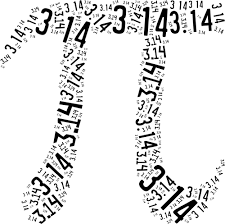
Introduction
The origin of Pi is a captivating journey that takes us through the annals of history. This mathematical constant, represented by the Greek letter π, is more than just a number. It’s a symbol of the universal language of mathematics and its profound connection to the world around us.
The Origin of Pi: Historical Background
Before diving deep into the civilizations that contributed to our understanding of Pi, it’s essential to grasp its historical significance. Pi’s allure isn’t just in its value but in the quest of ancient scholars to determine this mysterious number.
Ancient Egypt
The land of pyramids and pharaohs holds some of the earliest records related to Pi.
The Rhind Mathematical Papyrus and its approximation of Pi:
One of the most famous mathematical documents from ancient Egypt, the Rhind Papyrus, hints at an approximation of Pi. It dates back to around 1550 BC. Scholars believe that Egyptians used a value close to 3.125, derived from their understanding of geometry and the relationship between a circle’s diameter and its circumference.
How the ancient Egyptians used Pi in their architecture and construction:
Evidence suggests that the Great Pyramid of Giza’s dimensions might have been based on the value of Pi. The ratio of the pyramid’s perimeter to its height seems to approximate 2π, showcasing the Egyptians’ intuitive grasp of this constant.
Ancient Babylon
Moving eastward, the Babylonians had their own take on Pi.
Babylonian tablets and their calculations related to Pi:
Ancient tablets from Babylon, dated to between the 19th and 17th centuries BC, indicate that mathematicians of the time used a value of approximately 3.125 for Pi, strikingly similar to the Egyptians. These calculations, inscribed on clay, provide a glimpse into the mathematical prowess of this ancient civilization.
Comparison of Babylonian approximation to the actual value of Pi:
While 3.125 is a rough estimate, it’s fascinating to note that the Babylonians were on the right track over 4,000 years ago. Their approximation, though not exact, reflects a keen observation of circular shapes and their properties.
Ancient India
The subcontinent of India, with its rich history of mathematics and astronomy, also played a role in the story of Pi.
The use of Pi in Vedic literature:
Ancient Indian scriptures, particularly the Vedas, dated between 1500 ~ 1200 BC, contain hymns and verses that hint at the value of Pi. These texts, written in poetic form, often used metaphors and allegories to convey mathematical concepts.
Aryabhata’s approximation of Pi and its significance:
One of India’s most celebrated 5th century mathematicians, Aryabhata, in his seminal work Aryabhatiya, provided an approximation for Pi as 3.1416. His method, based on geometric calculations, was a significant step forward in refining the value of this constant.
Ancient Greece
No exploration of Pi’s history would be complete without delving into ancient Greece, a hub of mathematical and philosophical thought.
Introduction to Archimedes and his method of exhaustion:
Archimedes, the renowned Greek mathematician, introduced a groundbreaking method to approximate Pi. Using polygons inscribed within and outside a circle, he employed the method of exhaustion to inch closer to Pi’s true value.
Archimedes’ Pi approximation using polygons:
Through his innovative approach, Archimedes (287–212 BC) deduced that the value of Pi lies between 3 1/7 and 3 10/71. This range was a monumental achievement for its time and laid the foundation for future mathematicians to build upon.
Other Greek mathematicians and their contributions to understanding Pi:
While Archimedes stands out, other Greek scholars like Ptolemy (100–170) and Euclid (around 300 BC) also made noteworthy contributions. Their collective efforts, documented in various texts, enriched the world’s understanding of this enigmatic number.
Ancient China
As we traverse the globe, China emerges as another pivotal contributor to the legacy of Pi.
The work of Zu Chongzhi and his accurate approximation of Pi:
Zu Chongzhi (429–500), a brilliant mathematician of ancient China, achieved an astonishingly accurate approximation of Pi. He determined that Pi was between 3.1415926 and 3.1415927, a value that remained unsurpassed for nearly a millennium. His dedication to precision showcases the depth of mathematical understanding in ancient China.
The importance of Pi in Chinese mathematics:
Beyond Zu Chongzhi, Chinese scholars integrated Pi into various mathematical and astronomical calculations. Their work, often inscribed on bamboo strips or silk, reflects a civilization deeply engrossed in the mysteries of the universe.
Medieval Islamic World
The Islamic Golden Age, spanning from the 8th to the 13th century, was a period of immense intellectual growth, and the story of Pi is no exception.
The contributions of Islamic mathematicians like Al-Khwarizmi:
Al-Khwarizmi (780–850), often hailed as the father of algebra, made significant strides in refining the value of Pi. His works, which later influenced European mathematicians, underscore the interconnectedness of global mathematical endeavors.
The advancement in the understanding of Pi during the Islamic Golden Age:
Islamic scholars, drawing from Greek and Indian sources, furthered the study of Pi. Their meticulous calculations, often using geometric methods, brought forth a more nuanced understanding of this constant.
European Renaissance to Modern Day
The rebirth of scientific inquiry during the European Renaissance propelled the study of Pi to new heights.
The advent of calculus and its role in refining the value of Pi:
With the development of calculus by Sir Isaac Newton (1642–1727) and Gottfried Wilhelm Leibniz (1646–1716), mathematicians had a powerful tool at their disposal. This new branch of mathematics allowed for more intricate calculations, leading to even more accurate values of Pi.
Ludolph van Ceulen and his 35 decimal places achievement:
Ludolph van Ceulen (1540–1610), a German mathematician, dedicated much of his life to Pi. His crowning achievement was approximating Pi to 35 decimal places, a feat so significant that he had the value engraved on his tombstone.
The use of computers in the 20th and 21st centuries to calculate trillions of decimal places of Pi:
The digital age revolutionized the pursuit of Pi. Computers, with their immense processing power, have calculated Pi to trillions of decimal places. This modern quest exemplifies humanity’s undying fascination with this mathematical constant.
Symbolism and Adoption of the Greek Letter “π”
The symbol we associate with Pi wasn’t always its representative.
Introduction to the Greek mathematician William Jones and his introduction of the symbol:
In 1706, William Jones, a Welsh mathematician, introduced the symbol “π” to represent the ratio of a circle’s circumference to its diameter. His choice, drawing from the Greek word “periphery,” was both intuitive and fitting.
The adoption and universal acceptance of the symbol “π” to represent Pi:
Initially, the mathematical community was slow to adopt Jones’s notation. However, as its utility became evident, the symbol gained traction. Today, “π” is universally recognized, symbolizing not just a number but a journey spanning millennia.
Conclusion
The tale of Pi is more than a chronicle of a mathematical constant. It’s a story of civilizations, scholars, and the collective human endeavor to understand the cosmos. From ancient approximations to modern-day precision, Pi remains a testament to our insatiable curiosity and the boundless wonders of mathematics.


Leave a Reply